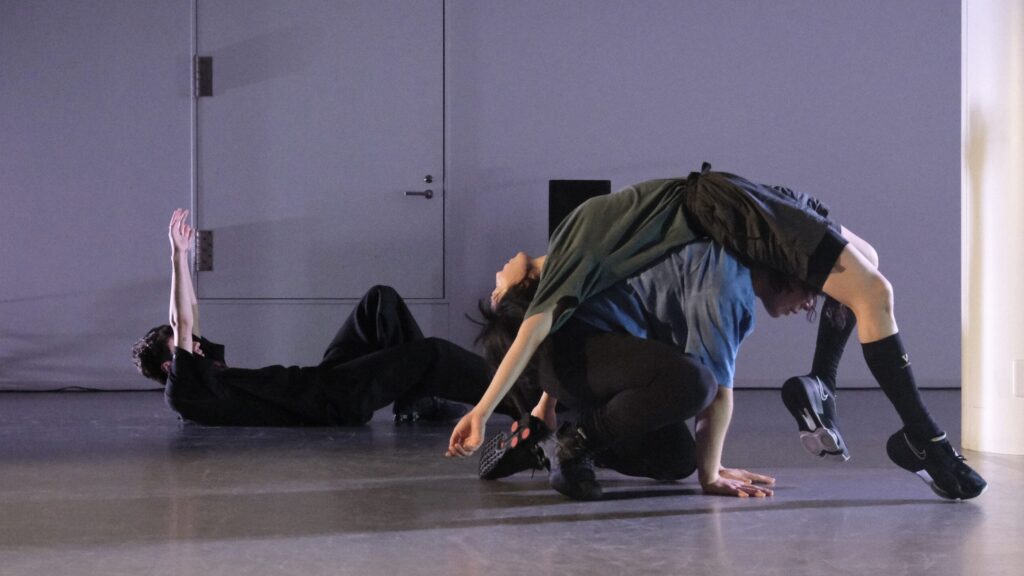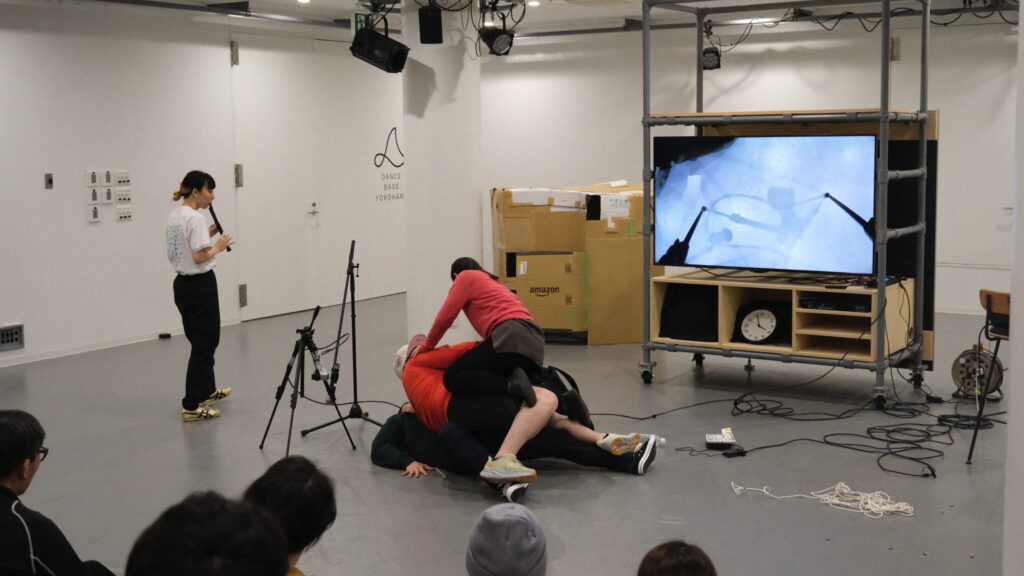In Remembrance of Physical Catharsis / Ayaka Ono Akira Nakazawa Nakazawa Spacenotblank Dance Work No. 1: Claude Debussy, “Exercises

Dance Work No. 1: Claude Debussy, Practice, Part 1|Work in Progress, January 2025, Dance Base Yokohama
For the moment, I can only take “Dance Work No. 1 ” as a bold gesture of rejection of the methodology that Space Not Blank has developed so far.
Physical Catharsis, a method of dance generation that Space Not Blank has been exploring since 2019, consists of various choreographic techniques such as form, replay, and balance, all of which have in common a unique preparation for performance in which the distinction between method and result, rehearsal and performance, becomes indistinct. The common denominator in all of them was a unique way of preparing for the performance, in which the distinction between method and result, rehearsal and performance became unclear. The traditional aesthetics of the work that makes a sharp distinction between the creative process and the performance was not adopted, and in fact, the artists avoided referring to their performances as dance works, an expression that implies completion, The principles of choreographic creation, which I have just described as “methods,” have been categorized and tried under the name of “phases.
In “physical catharsis,” dance is truly generated, and its owner is extremely ambiguous. Several dancers perform very short gestures of only a few seconds in the rehearsal space, and then connect their own movements with those of the other dancers. As the fragmented gestures are continued and placed like a game of shiritori or chess, a sequence of gestures is established before one knows it. The choreographer does not prepare phrases in advance. Nor are the gestures reduced to the creativity of the individual dancer. Movement is self-generated in the improvisational response inspired by the dancers’ interactions with each other.
The gestures thus produced, which are fragmentary and yet related to each other, are generated in the rehearsal room in bits and pieces, including the time of mutual perception, recognition, and thought, as in Shiritori and chess, but in the performance, they are deployed on stage at high speed all at once. Since these gestures are improvised, there is no need to interpret the meaning of the gestures in terms of symbols or motifs. Rather, what can be read is the similarity and correspondence between the gestures that are ignited moment to moment, and the process by which the gestures are generated, in other words, the past. In the case of physical catharsis, however, the process of generating gestures in the past is presented as a completed process after examination. In this way, the process of dance generation becomes the content of the dance, the method of dance and the result are now one and the same, and watching the dance becomes a paradoxical “event” in which the viewer sees the process of generation in the background of the completed stage.
However, ” Dance Work No. 1,” as its title already makes clear, was cut and closed as a work within the present framework of a performance. The dance is slowed down, and the individuality of the dancer’s body becomes more visible. Factors such as height, height-low, center of gravity, facial expression, and eye contact become semantic cues for deciphering the relationship between the dancers, and the content of the performance can be read in terms of dominance and non-dominance, intimacy and solitude, encounters and separations. Furthermore, the abundant use of lighting and music, which has been restrained in the past, further contributes to this semantic interpretation and assures that what is to be seen is in the midst of the ongoing “work” on stage (the subtitle of the piece, Claude Debussy’s “Exercises,” is even more meaningful). (It is increasingly significant that the music used, Claude Debussy’s “Exercise,” is given as the subtitle of the work.) ) The performance is disconnected from the production process, and the viewer’s gaze stops at the present moment on the stage.
From the comments made by Nakazawa Yo, who choreographed and directed the piece together with Ono Ayaka, during the after-talk, I was able to learn the artist’s thinking behind this shift. The main idea, as I understood it, was that the choreographer himself wanted to take on the responsibility of generating the intensity of expression, rather than relying on the identity and individuality of the performers. However, even if the modern concept of a work is useful as a mechanism for concentrating the responsibility of expression on the choreographer/director, it is not necessarily necessary to give up the traditional form of physical catharsis in which the process and performance are integrated. In this respect, “Dance Work No. 1,” which boldly attempted to depart from conventional production methods, seemed to me even regressive.
There is one more important change that must be added. It is the increase in physical contact between dancers. In conventional physical catharsis, contact that directly discloses the relationship between the bodies is kept to a minimum. In “Dance Work No. 1,” on the other hand, the dancers approach, run away from, and lean against each other. This open contact makes it possible to read “Dance No. 1 ” as a play of relationships.
About a year before “Dance Work No. 1,” Space Not Blank had presented Contact Gonzo’s work ” Choreographic Concept 001 for Untrained Amateurs/Study on Weight and Movement. The artists may have been interested in the use of contact as a content of the dance performance since that time. In terms of their orientation toward physical expression that is not bound by preconceived vocabularies, and in terms of their methodological and formalistic conceptions of dance, contact Gonzo and Space Not Blank may have had something in common. However, while “Untrained” had a strong improvisational and happening tone, and contact was presented as a present-tense event that could lead to unexpected situations, “Dance Work No. 1 ” had a strong sense of a “work” that had been prepared in advance.

The Inherited Body|Choreographic Concept 001 for Untrained Laypersons / Study on Weight and Movement, January 2024, Dance Base Yokohama
Space Knot Blank is a company that has presented both dance and theater at the same time, and in “Dance Work No. 1 ” the artist’s thoughts and hands are similar to those in their theater works when he encourages a semantic reading of the relationship between postures, gestures, and bodies. Looking forward, we should celebrate the birth of this theatrical dance as a great achievement of Space Knot Blank, which has continued its genre-crossing activities without considering the boundary between dance and theater to be self-evident. It is also interesting to ponder whether the speed of gesture and the presence or absence of physical contact are more essential to Space Knot Blank’s differentiation than genre.
What I want to see, however, is a stage where the graceful gestures of disconnection from the “past” in “Dance Work No. 1 ” are danced on the cusp of the next movement, a new development in their physical expression.
- For simplicity, we will abbreviate the term “space knot blank” in the text.
- Note that Space Not Blank presented a work-in-progress of “Dance Work No. 2” prior to this “No. 1” on April 26, 2024, but I have not seen it due to scheduling conflicts, and the details of the performance are unfortunately unknown.
April 10, 2025
Sakuya Uemura
Mentor: Mari Takeda (dance criticism)
The writing of this critique and feedback is part of Wings*.
*What is Wings
Dance Base Yokohama International Dance Project “Wings” for Emerging Creators
Dance Base Yokohama (DaBY) is launching a new project “Dance Base Yokohama International Dance Project “Wings” for Emerging Creators”. Dance Base Yokohama (DaBY) is launching a new project “Dance Base Yokohama International Dance Project “Wings” for the next generation of creators who want to spread their wings to the world. This project aims to increase the international presence of Japanese creators, nurture leading Japanese artists, producers, dramaturges and critics, and create opportunities for overseas performances and further revivals of their works.
Details of the project can be found on the web page below.
WINGS
▶︎ Dance Work No.3| Ayaka Ono Akira Nakazawa Nakazawa Spacenotblank


